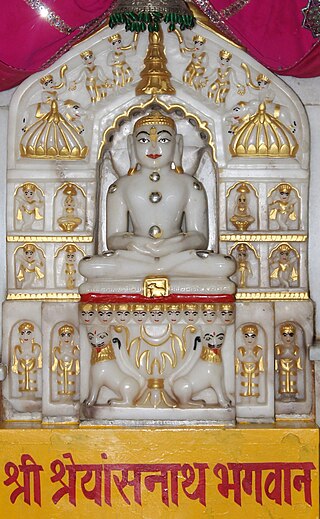Top Qs
Timeline
Chat
Perspective
Shreyansanatha
11th Tirthankara in Jainism From Wikipedia, the free encyclopedia
Remove ads
Shreyansanath was the eleventh Jain Tirthankara of the present age (Avasarpini). According to Jain beliefs, he became a Siddha – a liberated soul which has destroyed all of its karma. Shreyansanatha was born to King Vishnu and Queen Vishna at Simhapuri, near Sarnath in the Ikshvaku dynasty. His birth date was the twelfth day of the Falgun Krishna month of the Indian calendar.
Remove ads
Biography
Shreyansanath was the eleventh Jain Tirthankara of the present age (Avasarpini).[2] According to Jain beliefs, he became a Siddha – a liberated soul which has destroyed all of its karma. Shreyansanatha was born to King Vishnu and Queen Vishna at Simhapuri, near Sarnath in the Ikshvaku dynasty. His birth date was the twelfth day of the Falgun Krishna month of the Indian calendar.[2] His height is mentioned as 80 dhanusha.[3] He is said to have lived for 8,400,000 years.[3]
Shreyansnath Bhagwan's Deshna inspired many to take Diksha and achieve Keval-Gnan and Moksha (liberation). He attained Nirvana from Sammed Shikharji Mountain, along with many Sadhus, Sadhvis, Shravakas, and Shravikas.[citation needed]
Shreyansanatha is said to have been born 9,999,900 sagara after his predecessor, Shitalanatha.[3] His successor, Vasupujya, is said to have been born 54 sagara after him.[3]
Remove ads
Teachings on Nirjara
Summarize
Perspective
Shreyansnath Swami's teachings emphasized Nirjara, the discharge of karmas. He explained that karmas are in stages of charging and discharging, with Nirjara being the stage of discharge. He distinguished between Akaam Nirjara (discharge without purpose) and Sakaam Nirjara (discharge with purpose). For a self-realized person, Sakaam Nirjara ensures that no new karmas are charged, as they remain vigilant in their awareness of being a Knower and Seer. Shreyansnath also highlighted the importance of penance (tapa) in achieving Sakaam Nirjara. He categorized penance into two types: Bahya Tapa (external penance) and Abhyantar Tapa (internal penance).[citation needed]
Bahya Tapa
The six types of Bahya Tapa are:
- Anshan (fasting)
- Unodari (eating less)
- Vrutti Sankshep (limiting desires)
- Ras Tyag (abstaining from taste)
- Kayotsarg (meditation)
- Sanlinta (modesty)
Abhyantar Tapa
The six types of Abhyantar Tapa are:
- Prayashchit (repentance)
- Vaiyavach (service to saints)
- Swadhyay (study of the self)
- Vinay (humility)
- Vyutsarg (renunciation)
- Dhyan (meditation)
Through Abhyantar Tapa, true karmic shedding occurs. Practices like Prayashchit help cleanse sins, while maintaining equanimity and viewing others as innocent aids in achieving liberation.[citation needed]
Remove ads
Main Temple
The Sarnath Jain Tirth temple located at Sarnath, Varanasi is one of the main shrines of Shreyansanatha.
Gallery
See also
Wikimedia Commons has media related to Shreyansanatha.
References
Wikiwand - on
Seamless Wikipedia browsing. On steroids.
Remove ads






